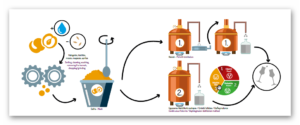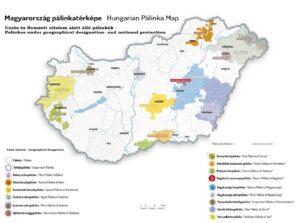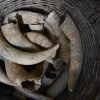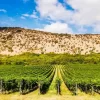What
Hungarian fruit distillate made entirely out fruit and fruit only. If there is one point you take away, it should be this: pálinka = 100% fruit spirit.
The ingredient listing on the back of the bottle states usually the given fruit and (e.g. purified) water. Later is used to adjust the alcohol as common with other spirits in the world as well.
Why
Historical evidence states that Károly Robert´s wife, Queen Erzsébet (Elisabeth) used to cure her gout with rosemary infused wine brandy, this was later called Aqua vitae reginae Hungariae (the Hungarians Queen´s water of life). At the very beginning the term “brandy” (or burned wine, égetett bor in Hungarian) was used for fruit and grain based spirits as well. To jump in time the word “pálinka” was most likely mentioned in 1630 to start to distinguish the distillate between fruit and cereal yet the word fruit (gyümölcs in Hungarian) was used as a pre-fix to enhance such distinction.
To fast forward once again in time; the 2002 Food Act regulated the very basics of pálinka, as from this date on only 100% fruit (aromas got forbidden, etc.) could be used in the production.
When
Pálinka can be produced all year around. However, certain fruit types grow, ripen at different seasons and its often best to adjust the production accordingly as fresh fruit as natural sugar is key. While distilled pálinka can set aside to be rested, blended or even aged and released at a later stage. Apple for instance will be picked in autumn around October-November, apricot around July and plum in autumn again. Within the different fruit types there are also earlier or later ripening varieties too. Right harvest and sound fruit is really the very first step in producing the fine spirit.
How
Key is healthy fruit – as mentioned above- since by law no sugar is permitted at any stage of the production. Ripe fruit is picked and depending on the fruit type mashed; if necessary seeds, kernels are removed and mostly likely discarded in the process as it can affect aromas, flavours rather negatively. After mashing the juice is fermented to produce from the natural sugar with the assistance of yeast alcohol. The low alcohol liquid is distilled to the final spirit, needless to say the cut of point and to find “the hearth” or middle cut is crucial and to make things difficult, every fruit has a different cut off point. Some producer prefer the so called small pot (kisüsti) form of batch distillation method, some go for the continuous method (column still), some even mix both.
The basic formula could go something like this: fruit – mashing – fermentation – distillation – final spirit. While this sounds simple yet every fruit type has a different approach in the process of production. Based on their sugar ratio, type, aroma and flavour profile. As well as further steps come into play if a producer decides to make a so-called “ágyas” bedded pálinka. Whereby fresh or dried fruit is added to the final product to soften yet enhance the original aromas of the fruit as well. Not to mention blending of two or three different fruit spirits is gaining popularity as well as the proper use of oak barrel ageing too.
Source: Pálinka of Excellence 2017
How would you consume it? Firstly in moderation. Second; it´s worth to build it into the gastronomy, hence with some food. Have it at “room temperature”, around 18°C and use a proper glass. Savour it like you would do with any fine spirit.
Where
The short answer is: throughout of Hungary. As Pliny the Elder (Roman author and naturalist) referred to the today´s Hungarian land in the Historia Naturalis: “Fruit growing Pannonia”, reflecting the outstanding capabilities of fine fruit growth potential. Hungary is right in the so-called fruit belt which goes across various European countries, very generously speaking -and not taking other circumstances into account – between the 40°-50° latitude.
However, there are a number of more specific regional pálinkas highlighting usually one distinct fruit type to a closer, smaller and more confined provenance. The map (below) explains this in more detail and as in the case of every protected designation (here geographic indication/PGI) there is a set of rules embedded in the product specification, highlighting the natural conditions (e.g. soil, climate) and human properties (e.g. fruit types grown, work in the orchards and in the distillery) which give the individual character of the regional pálinka. Based on this Apricot Pálinka of Gönc is very different from the Apricot Pálinka of Kecskemét, both PGI´s respectively.
Source: Pálinka of Excellence 2019/20
Who
Most people proudly and often all too loosely use and refer to their own “home-made” product as pálinka. But the product as well as the whole production process is strictly governed by law and legislations, such as the Regulation EC No 110/2008 and the decree of 2008. LXXIII. This later states that the domestically distributed pálinkas must have a specified custom seal as well as only custom certified warehouses are allowed to issue such seal through the supervision of the tax office. Roughly there are 140 commercial distilleries who are allowed to produce pálinka as such. There are a number of contracted distilleries as well and there is a legal path to create pálinka for the generic public as well.
Final conclusions beyond the legal frame work, pálinka is the very essence of the fruit, hence we like to use the term: Spirit of the Fruit!







